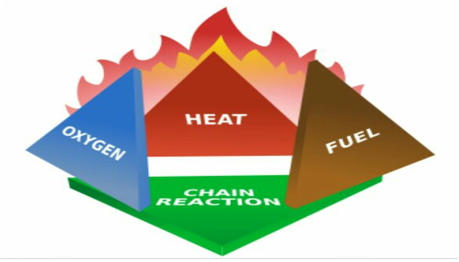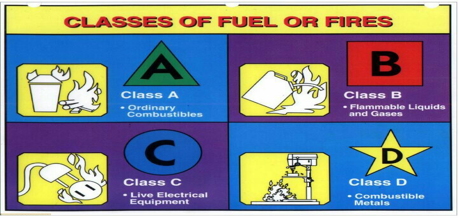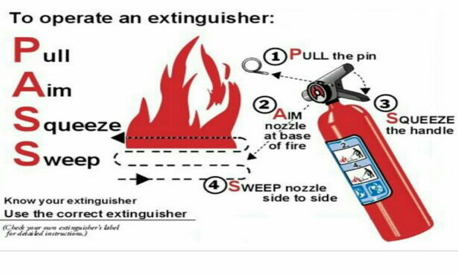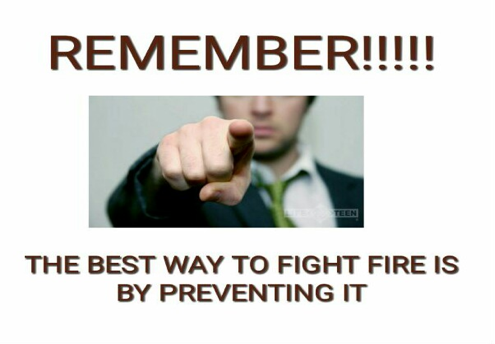Over the past few months, there has been increasing cases of fire incidents leading to injury, destruction of property, loss of life and investment. The incidents happened and escalated for various reasons such as: lack of knowledge, absence of emergency procedures, absence of firefighting equipment and absence of emergency exits.
Fire is one of the fastest ways to destroy a thing, as such when it occurs, it has to be tackled speedily and efficiently. For a fire to occur, you need 3 key elements:
1) Fuel (anything that can burn)
2) Oxygen
3) Heat (sufficient high temperature)
Based on this, a fire can occur anywhere and at any time. However it is important to mention the fourth element, without which a fire would not occur despite the presence of the other elements.
4) Chemical Reaction
This is the reason we walk around every day without catching fire irrespective of the combustible stuff around us or on us, the free flow of oxygen and the heat. The chemical reaction would only occur or be sustained when one or more of the elements is sufficient to sustain the burn. For example, without sufficient heat, no matter the amount of oxygen or fuel present, the chemical reaction would not occur and a fire won’t start.

CLASSES OF FIRE
Fire can occur at home, at work and on the roads. It is important to know the different classes of fire and the best way to deal with it. Depending on the vicinity of the fire and the attendant risks, you could need a fire blanket (kitchen), Dry Chemical Powder (DCP) extinguisher, CO2 extinguisher or plain old water.
Class A: this refers to fire from ordinary materials that can produce ash like paper, wood, textile, bags. It can be extinguished by using water, non-flammable liquids and appropriate fire extinguishers.
Class B: this refers to fire resulting from flammable liquids and gases such as gasoline, grease, propane. Do not use water for this class as it would spread the fire. Appropriate extinguishers are useful for this class of fire.
Class C: this is fire from live electrical sources. It could be as a result of an overloaded socket, power surge, faulty wiring etc. Do not use water to avoid electrocution. If possible, cut off the power supply first before attempting to fight the fire. Appropriate extinguisher is useful here.
Class D: this is fire from combustible metals like magnesium, titanium. Appropriate extinguishers can put out this class of fire.

METHODS OF EXTINCTION
A removal of any of the key elements would extinguish the fire. There are 3 major ways to extinguish a fire:
Cooling: this is the removal of heat by reducing the temperature of the burning substance. Water, non-flammable fluids and water fire extinguishers help in this regard.
Smothering: this is the removal of oxygen by reducing the oxygen content of air in that vicinity. This could be achieved with blankets, coats, curtain, covering a container (waste bin with a cover) or specific fire extinguishers.
Starving: this is the removal of fuel. It could either be by removing the fire from the vicinity of combustible materials or removing fuel from the vicinity of the fire.
FIRE FIGHTING EQUIPMENT
The best way to fight a fire is to prevent it. However, because accidents are unplanned, it is important to be prepared by being informed and purchasing relevant equipment. There are various equipment but only the ones suitable for your type of business or scale of operation should be purchased. A personal kitchen might need just a fire blanket or a fire extinguisher while a big hotel’s kitchen would most likely need a sprinkler system. The major firefighting equipment are:
· Detectors and alarms
· Fire blanket
· Fire extinguishers (Dry Chemical Powder, CO2, Foam, Halon, Water Glycol)
· Sprinkler System
· Hose reels
ACTIONS TO TAKE
· Raise alarm (shout for help, trigger the alarm system, call the fire service)
· Exit building if you’re not competent to fight the fire

· If you are competent, get the fire extinguisher and follow the PASS principle

· If you are competent and the fire is beyond your scope (knowledge and materials available), exit the vicinity.
· Always ensure the bottle is held upright
· Target the base of the fire to ensure effectiveness
FIRE PREVENTION TIPS
· Always turn off electrical appliances when not in use
· All homes and offices should put in place detection and evacuation systems (procedures and training)
· Report faulty equipment
· Ensure that only a competent personnel wearing appropriate personal protective equipment (PPE) is allowed to repair faulty equipment
· Turn off gas cylinders when not in use
· Keep flammable materials properly labelled and away from others
· Always follow laid down procedures when working with flammable materials





